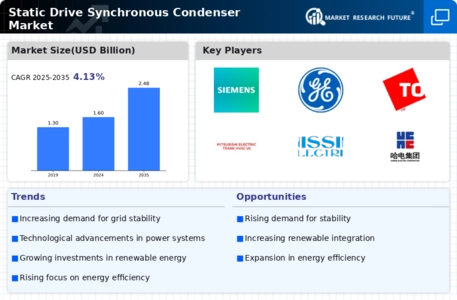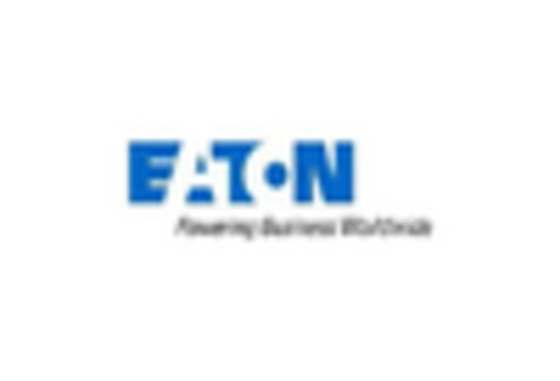The Static Drive Synchronous Condenser Market is currently characterized by a dynamic competitive landscape, driven by the increasing demand for grid stability and renewable energy integration. Major players such as General Electric (US), Siemens (DE), and ABB (CH) are at the forefront, each adopting distinct strategies to enhance their market positioning. General Electric (US) emphasizes innovation in energy solutions, focusing on advanced technologies that improve efficiency and reliability. Siemens (DE) is actively pursuing regional expansion, particularly in emerging markets, to capitalize on the growing need for synchronous condensers. Meanwhile, ABB (CH) is leveraging digital transformation initiatives to optimize its product offerings and enhance customer engagement, thereby shaping a competitive environment that prioritizes technological advancement and customer-centric solutions.
In terms of business tactics, companies are increasingly localizing manufacturing to reduce costs and improve supply chain efficiency. The market appears moderately fragmented, with a mix of established players and emerging entrants. This structure allows for a diverse range of offerings, yet the collective influence of key players like Mitsubishi Electric (JP) and Schneider Electric (FR) is significant, as they drive innovation and set industry standards.
In August 2025, Mitsubishi Electric (JP) announced a strategic partnership with a leading renewable energy firm to develop next-generation synchronous condensers tailored for offshore wind applications. This collaboration is poised to enhance Mitsubishi Electric's product portfolio and position it as a leader in the renewable energy sector, reflecting a broader trend towards integrating renewable sources into traditional power systems. The strategic importance of this move lies in its potential to address the growing demand for grid stability in regions heavily reliant on wind energy.
In September 2025, Schneider Electric (FR) unveiled a new line of smart synchronous condensers designed to optimize energy storage and enhance grid resilience. This launch underscores Schneider Electric's commitment to sustainability and innovation, as it seeks to provide solutions that not only meet current energy demands but also align with global sustainability goals. The introduction of smart technology into their product line indicates a shift towards more intelligent energy management systems, which could redefine operational efficiencies in the market.
Furthermore, in July 2025, Siemens (DE) completed the acquisition of a technology startup specializing in AI-driven energy management solutions. This acquisition is likely to bolster Siemens' capabilities in predictive maintenance and operational optimization, allowing the company to offer more sophisticated solutions to its customers. The strategic importance of this acquisition lies in its potential to enhance Siemens' competitive edge by integrating cutting-edge technology into its existing product offerings, thereby addressing the increasing demand for smart grid solutions.
As of October 2025, the competitive trends in the Static Drive Synchronous Condenser Market are increasingly defined by digitalization, sustainability, and the integration of artificial intelligence. Strategic alliances are becoming more prevalent, as companies recognize the need to collaborate to enhance their technological capabilities and market reach. Looking ahead, competitive differentiation is expected to evolve, shifting from traditional price-based competition to a focus on innovation, advanced technology, and supply chain reliability. This transition suggests that companies that prioritize these aspects will likely emerge as leaders in the market.


















Leave a Comment